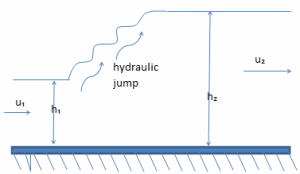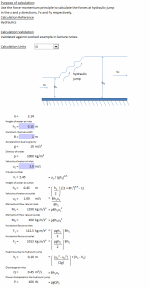Force-momentum fluid at hydraulic jump.xls

Description
Purpose of calculation: Use the force-momentum principle to calculate the forces at hydraulic jump in the x and y directions, Fx and Fy respectively.
Calculation Validation: Validated against worked example in lecture notes.
Calculation Reference
Hydraulics
Fluid Mechanics
Forces resulting from fluid jets, flow over plates, vanes, and through pipes are important considerations in fluid mechanics and engineering. These forces are created by the interaction between the fluid and the solid surfaces, and can have significant effects on the performance and efficiency of various systems, such as pumps, turbines, and heat exchangers.
Fluid jets: The force resulting from a fluid jet depends on the velocity and mass flow rate of the jet, as well as the angle and shape of the surface it impacts. The force can be calculated using the formula F = ρQV, where F is the force, ρ is the density of the fluid, Q is the mass flow rate of the jet, and V is the velocity of the jet.
Flow over plates: The force resulting from fluid flow over a plate depends on the velocity and viscosity of the fluid, as well as the shape and orientation of the plate. The force can be calculated using the formula F = 1/2ρAV^2Cd, where F is the force, ρ is the density of the fluid, A is the cross-sectional area of the plate, V is the velocity of the fluid, Cd is the drag coefficient, and 1/2ρAV^2 is the dynamic pressure of the fluid.
Vanes: The force resulting from fluid flow over vanes depends on the shape and orientation of the vanes, as well as the velocity and viscosity of the fluid. The force can be calculated using the formula F = ρQVsin(θ - α), where F is the force, ρ is the density of the fluid, Q is the mass flow rate of the fluid, V is the velocity of the fluid, θ is the angle of the vane relative to the flow direction, and α is the angle of the jet or fluid flow.
Through pipes: The force resulting from fluid flow through a pipe depends on the velocity and viscosity of the fluid, as well as the diameter and roughness of the pipe. The force can be calculated using the formula F = ρQV, where F is the force, ρ is the density of the fluid, Q is the mass flow rate of the fluid, and V is the velocity of the fluid.
These forces resulting from fluid jets, flow over plates, vanes, and through pipes can be used to analyze and design various fluid systems, and are critical for ensuring efficient and effective operation.
Calculation Preview
Full download access to any calculation is available to users with a paid or awarded subscription (XLC Pro).
Subscriptions are free to contributors to the site, alternatively they can be purchased.
Click here for information on subscriptions.


